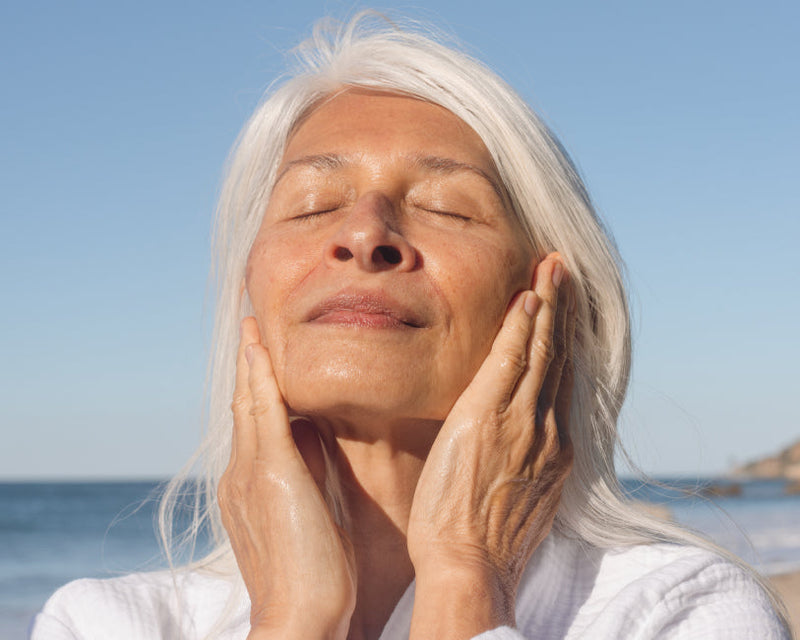Written by OSEA Staff | Published May 1, 2025
One of the most common questions we get is: "How to get rid of wrinkles." No matter your ethnicity, gender, or skin type, if you’re lucky, you’ll get wrinkles. And yes, we do mean lucky—aging is a privilege, after all. Those little creases along our foreheads and at the corners of our eyes are a natural part of the human experience and they can surface as early as your mid-20s.
To help answer that question, we turned to Ritual, the multivitamin and wellness brand known for its science-backed formulas and in-house team of expert researchers. Together, we unpacked what’s happening beneath the surface as wrinkles form, why some lines deepen more quickly than others, and what science says about slowing the process.
Ahead, the science experts at Ritual share what you really need to know about skin aging—and the smart steps you can take today to support smoother, stronger, more resilient skin tomorrow.
What exactly causes wrinkles to form, and why do they become more prominent with age?
Ritual: Wrinkles form due to a combination of structural, mechanical, and biochemical changes in the skin that occur with age1. Over time, the epidermis (outer layer of the skin) becomes thinner and drier, while the dermis (middle layer) gradually loses collagen and elastin, reducing the skin’s strength and elasticity. Repeated facial expressions, gravity, and environmental stressors contribute to the deepening of lines and creases5. While dry skin doesn’t directly cause wrinkles, it can make them more noticeable. Hydrated skin tends to look smoother and can make wrinkles less visible.
Can you explain the difference between intrinsic and extrinsic aging? How do they each contribute to wrinkle formation?
Ritual: Intrinsic aging is driven by genetic, hormonal, and metabolic factors. It causes slower cell turnover and loss of collagen and elasticity. Extrinsic aging, caused by external influences like UV radiation, pollution, and smoking, accelerates wrinkle formation through collagen breakdown and oxidative damage34.
Can you explain the difference between fine lines, crow’s feet, wrinkles, and deep wrinkles?
Ritual: Fine lines are shallow and often the earliest signs of aging. Deep wrinkles are more pronounced and form from structural breakdown over time. Crow’s feet are a specific type of wrinkle caused by expressions like squinting. Other location-specific wrinkles include laugh lines and frown lines14.
Are certain skin types more prone to wrinkles than others?
Ritual: All skin types age, but lighter skin tones (Fitzpatrick types I and II) are more prone to photodamage from UV exposure4. These skin types have less melanin, which offers some natural protection. Regardless of skin type, consistent sun protection helps reduce wrinkle risk.
Fine lines are often the first visible sign of aging—what's happening at a cellular level when they start to form?
Ritual: Fine lines form as the epidermis thins and the dermis loses collagen and elastin. Sebaceous glands also produce less oil, especially after menopause, making skin drier and more wrinkle-prone45.
Crow’s feet are commonly associated with smiling and squinting—can facial expressions alone lead to wrinkles, or are other factors at play?
Ritual: Facial expressions contribute to wrinkles, but intrinsic aging and extrinsic factors like UV damage and smoking also play significant roles. Loss of elasticity makes dynamic lines turn into static wrinkles over time15.
How do deep wrinkles differ structurally from fine lines and early wrinkles?
Ritual: Fine lines are shallow and linked to natural aging. Deep wrinkles are wider and deeper, often caused by external damage like sun exposure and smoking, which degrade collagen more significantly4.
Sun exposure is often called the biggest culprit for premature wrinkles—how exactly does UV damage impact skin aging?
Ritual: UVA and UVB rays damage the skin at different depths, accelerating collagen breakdown and weakening cell repair. This leads to thinner skin, reduced elasticity, and more pronounced wrinkles over time67.
How do factors like pollution and smoking contribute to wrinkle formation?
Ritual: Smoking and pollution both create oxidative stress, triggering inflammation and collagen loss. Studies show smokers develop more severe wrinkles than non-smokers78. Pollution similarly contributes to premature skin aging, especially in sun-exposed areas.
Are there any lifestyle habits that can significantly slow down or prevent wrinkle formation?
Ritual: Yes. Sun protection, a healthy diet, hydration, consistent skincare, and physical activity all support skin health. Limiting sugar, salt, and unhealthy fats can also reduce wrinkle development4.
Is it possible to "reverse" wrinkles, or is the goal to slow down their progression?
Ritual: Wrinkles can’t be fully reversed, but their appearance can be improved. Treatments and preventative care, like SPF and targeted skincare, help slow the progression of aging and support skin structure3.
Sources
1 Choi JW, Kwon SH, Huh CH, Park KC, Youn SW. The influences of skin visco-elasticity, hydration level and aging on the formation of wrinkles: a comprehensive and objective approach. Skin Res Technol. 2012;19(1):e349–55.
2 Clarke LH. Physical appearance changes across adulthood - women. Encyclopedia of Body Image and Human Appearance. 2012:602–607.
3 Ganceviciene R, et al. Skin anti-aging strategies. Dermato-Endocrin. 2012;4(3):308–319.
4 National Library of Medicine, MedlinePlus. Aging changes in skin. U.S. National Institutes of Health. 2022.
5 Shin JW, et al. Molecular Mechanisms of Dermal Aging and Antiaging Approaches. Int J Mol Sci. 2019;20(9):2126.
6 National Institutes of Health. News in Health: Sun and Skin. 2014.
7 Morita A. Tobacco smoke causes premature skin aging. J Dermatol Sci. 2007;48(3):169–75.
8 National Institute of Arthritis and Musculoskeletal and Skin Diseases. Healthy Skin Matters. 2020.
9 Wong QY, Chew FT. Defining skin aging and its risk factors: a systematic review and meta-analysis. Sci Reports. 2021;11:22075.
 Body Oil
Body Oil
 Body Moisturizers
Body Moisturizers
 Cleansers
Cleansers
 Body Scrubs
Body Scrubs
 Face Moisturizers
Face Moisturizers
 Travel & Sets
Travel & Sets
